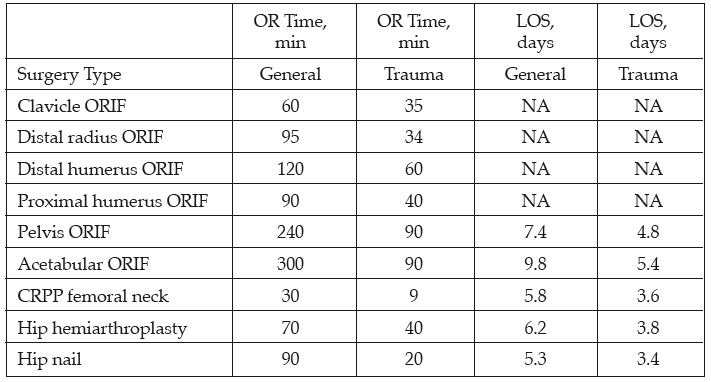
Sat., 10/6/12 General Interest, PAPER #106, 2:30 pm OTA-2012
Operating Room Efficiency: Benefits of an Orthopaedic Traumatogist at a Level II Trauma Center
Peter L. Althausen, MD, MBA; Daniel John Coll, MHS, PA-C; Timothy J. O’Mara, MD;
Timothy J. Bray, MD;
Reno Orthopaedic Clinic, Reno, Nevada, USA
Purpose: OTA fellowship survey data have suggested recent fellowship-trained orthopaedic trauma graduates are having difficulty obtaining “first choice” employment positions at the time of graduation. This new market dynamic represents changes in employment opportunities, hospital-based saturation of trauma positions, disinterest in private practice models, and declining reimbursement formulas. Fellowship-trained orthopaedic traumatologists (FTOTs) are taught skill sets that result in “best practice” outcomes and more efficient use of hospital resources that result in more favorable economic opportunities when compared to general orthopaedic surgeons (GOS) providing similar clinical services. The purpose of our study was to compare the operating room utilization and outcome data of FTOTs versus GOS. The data can be used to convince hospital systems committed to the trauma mission that they should continue hiring FTOTs knowledgeable in supply chain management (SCM).
Methods: Our institutional database was queried to identify all orthopaedic fracture cases performed at our institution from January 2009 to January 2010. Operative records were reviewed to determine time to operating room (OR), operative times, estimated blood loss (EBL), and intraoperative complications. Patients were stratified according to those treated by our trauma panel’s three FTOTs and those treated by the 18 other orthopaedic surgeons on our trauma panel. These two groups were then compared using standard statistical methods.
Results:


LOS, length of stay; ORIF, open reduction and internal fixation; CRPP, closed reduction and percutaneous pinning
Conclusion: This study demonstrates that at our community-based trauma system fracture care provided by FTOTs results in improved utilization of hospital-based resources when compared with equivalent services provided by GOS. Decreased operative times, shorter time to the OR, decreased LOS, and reduced complication rates by the fellowship- trained group represent enhanced control of the design, plan, execution, and monitoring (SCM) of orthopaedic trauma care. By creating increased “net value” to the hospital, newly trained orthopaedic traumatologists can use these data to negotiate more favorable employment contracts with “trauma-friendly” provisions for daytime ORs, physician assistants, equipment, and administrative assistance.
Alphabetical Disclosure Listing (808K PDF)
• The FDA has not cleared this drug and/or medical device for the use described in this presentation (i.e., the drug or medical device is being discussed for an “off label” use). ◆FDA information not available at time of printing. Δ OTA Grant.